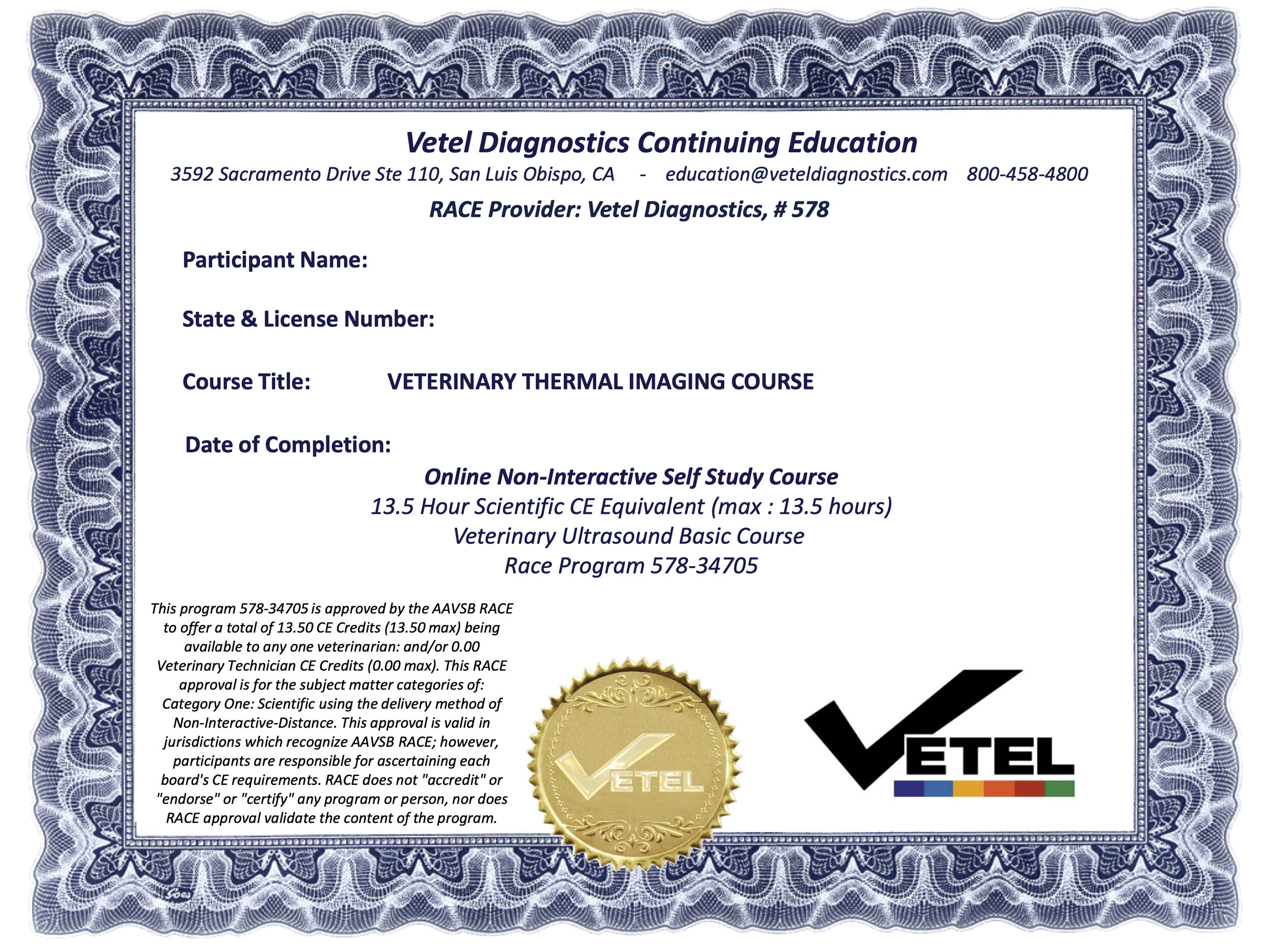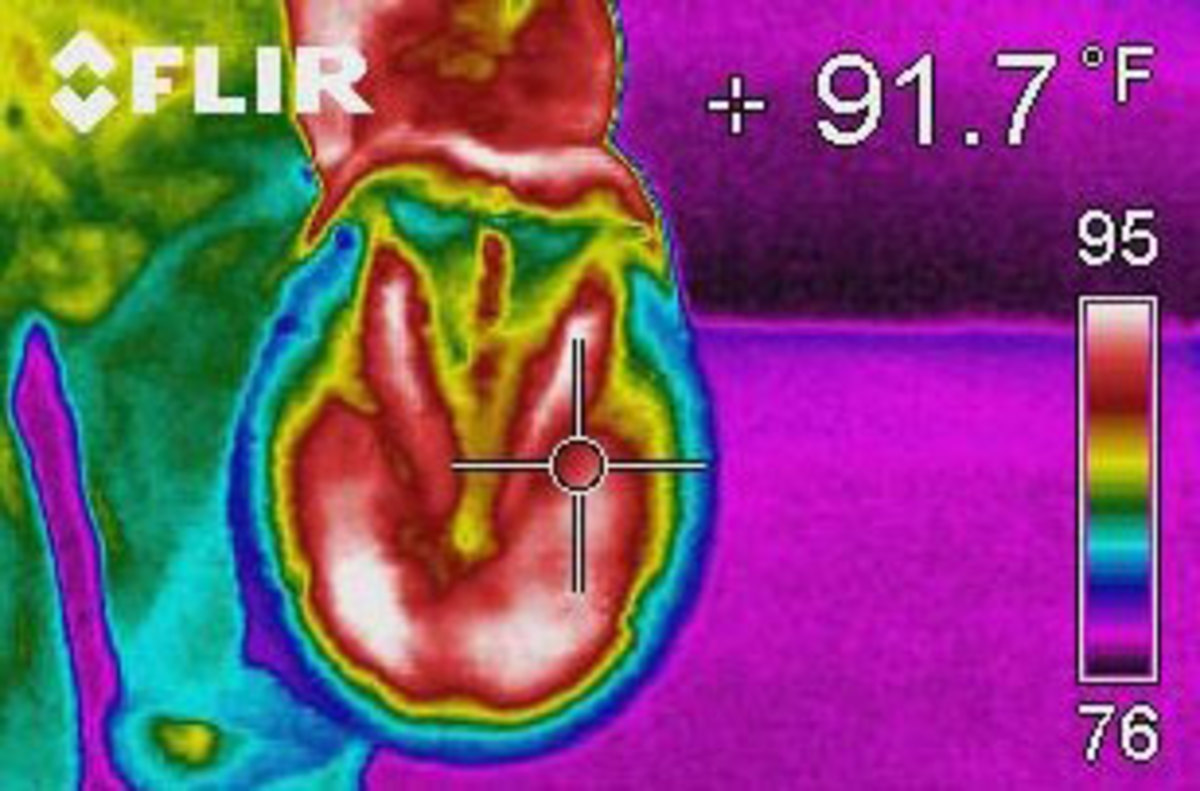+ Overview of the American Academy of Thermology Certification and Education Program
- NOTE: We use the terms "Thermology" and "Thermography" interchangably throughout these pages.
- This program offers appropriate training for prospective Equine PEMF Technicians wishing to further their employment and effectiveness as Equine Care Specialists with an optional American Academy of Thermology Equine Thermal Imaging Specialist (AAT-ETIS) Certification.
- This program will provide any Equine Care Specialist with the opportunity to develop both core and advanced medical imaging skills and an advanced understanding of infrared thermal imaging (also known as Thermography) for the equine.
- An American Academy of Thermology (AAT-ETIS) Member Certification validates the Equine Care Specialist's commitment to education and training in equine medical thermal imaging.
- Successfully completing all of the components of an AAT Member Certification program means that the candidate has met the AAT Member Certification requirements and has demonstrated the minimum necessary skills for the clinical administration of medical infrared thermal imaging on equines and has the knowledge base needed to articulate the pathophysiology under study.
- AAT-ETIS Member Certification qualification courses are open to both members and nonmembers; however, only AAT Members can be recognized as having been certified by AAT. The online course, now available through Vetel Diagnostics, meets these crucial course requirements.
- The candidate will be required to successfully complete the online course which includes the submission of three case studies.
- Upon successful completion, the candidate will receive a "Certificate of Completion."
- The candidate will then be eligible to receive a certification through ATT as an Equine Thermal Imaging Specialist.
+ PROCESS TO SECURE YOUR AAT-ETIS CERTIFICATION
+ Basic Thermology Education and Course Content
- The online course will allow the Technician to understand and build a specific focus on the following areas:
- Thermoregulation of the equine / Successful equine imaging
- Factors that determine skin temperature / Inflammation / Physiology of blood flow
- Clinical use / Mechanics by which the horse exchanges heat
- Injuries in the equine during exercise, training and performance
- What types of injuries to look for in horses doing different disciplines
- Accidental injuries in different sports. The use of thermography as a monitoring tool for the equine
- Exercise and the effects of exercise on physiology / Recovery and monitoring horses during rehabilitation / Pathophysiology
- Correct scanning / Correct report procedures / Environmental factors / Physics of infrared / Applications of thermography in the equine / Thermal tuning
- To study the principles and practice of equine and veterinary infrared thermography.
- To understand the process and physics of infrared and heat relating to the thermography application.
- Understand the environmental factors that can affect scanning results and practice to ensure correct protocols are adhered to at all times.
- Understand how to scan systematically, standardized scanning techniques and other factors.
- How to transfer scan images to the reporting software and manipulate the level and span to highlight areas of interest.
- How to produce a report for your client and their respective veterinarian using comparative analysis and to critically articulate one’s findings to ensure a professional, concise and accurate report based on standards and protocol.
+ Your Business and Career Opportunity with an EquiPulse PEMF AND Thermal Imaging Business Package
- Provide EquiPulse PEMF applications and generate generous profit margins like thousands of Equine PEMF Technicians do around the country.
- Thermology assessments:
- Provide a highly sensitive, early indicator of subtle circulatory changes in soft tissue.
- Reveal inflammatory reactions in joints and tendons 2 – 6 weeks prior to the clinical appearance of lameness.
- Identify abnormalities when tissues are in a state of stress rather than anatomical disruption.
- Provide Equine PEMF Technicians with the opportunity to show the efficacy of the PEMF application.
- Now you can offer PEMF and Thermology in one complete package and increase your income and improve application outcomes.
- Included in your purchase is 1 full year of online RACE accredited veterinary specific thermal imaging training. AAT Certification is optional.
- Whether you are a veterinarian, a farrier, an Equine Care Specialist or you are starting a new career, we want to help you by offering significant discounts off a complete business package. If you are ready to offer PEMF technology lock in your savings immediately Here!!
+ How does an Equine Digital Thermology Technician fit into the continuum of Care?
- When looking at the human medical industry’s human resource hierarchy, we see individuals who are licensed in a myriad of specialties. Their specific licenses allow them to perform within a scope of practice.
- Licensed MDs, physician assistants, physical therapists, nurses, X-ray technicians, and so on, perform very specific functions, applications or procedures. For example, you will not find a licensed physical therapist giving any injections, but a licensed nurse is able to by law. Physical therapists are allowed to prescribe, but only within a relatively narrow context of physical therapy prescriptive medicine.
- Today, the American Veterinary Medical Association has more than 91,000 members who are all licensed by state vet boards. (Review of recent rulings by the American Veterinary Medical Association)
- The bottom line is, if one is not a licensed vet or working under the direct supervision of a vet, the individual is "practicing veterinary medicine" without a state license and is subject to disciplinary action by the respective state board.
- There are "Certified Equine PEMF Practitioners" who have been served with cease and desist orders by the Colorado State Vet Board.
- Being a “Certified Anything” in the animal world without a state license is putting a big, red bullseye on that practitioner’s forehead and telling state vet boards, “I am easy to find. Come get me.”
- In a human medical practice, those who are licensed to prescribe within a limited scope of practice are called medical technicians and are licensed to apply technology to patients, i.e., X-Ray, MRI, surgical, dental and clinical lab technicians.
- Unless a Digital Thermologist holds a veterinary license, their scope of practice is limited to the use and production data for a licensed vet to properly interpret. This does NOT mean that the thermologist must not express their opinion when asked. They just do not diagnose, prescribe or make medical claims. It is all in how the thermologist communicates within the orbit of horse owner, trainer, farrier and licensed veterinarian.
- By sharing thermography data through appropriate language and terms, a local veterinarian community will see the Certified AAT-ETIS Thermologist in a more professional light, when the thermologist is applying PEMF technology and properly using a thermography camera.
- The operative language to use is “Data Collection” rather than “Diagnostic.”
- Certified AAT-ETIS Technicians will “apply” a therapeutic modality and/or employ an assessment tool with their thermographic camera to collect information and share it with stakeholders.
About Vetel’s Online Thermography Course
+ Vetel's Online Thermal Imaging Education
- Our online thermal imaging education is open to veterinarians, trainers, farriers, and private owners who wish to expand their education in the applications of veterinary thermography.
- This course encompasses proper techniques for clear and concise thermographic exams, reviews case studies, and uncovers assorted artifacts you may encounter during an exam. Upon successful completion of this course, participants will have a working knowledge of proper patient positioning, the management of artifacts, the normal thermographic patient presentation, disease entities and applications where thermal imaging is best utilized, and integration with other diagnostic modalities.
+ Vetel's Online Thermal Imaging Educators
+ These board certified experts in veterinary thermology will present course material in the following areas:
- TH‐01 Thermography ‐ Introduction and Safety Around Animals
- TH‐02 Thermography ‐ Artifacts, Environmental Concerns & Physiology
- TH‐03 Performing the Normal Equine Thermographic Examination
- TH‐04 Thermography of the Equine Limbs: the foot, joints, tendons and ligaments
- TH‐05 Thermography of Back Pain in Horses
- TH‐06 Thermography in Equine Practice
- TH‐07 Thermography ‐ Selected Equine Case Presentations
- TH‐08 Thermal Imaging and Equine Rehabilitation
- TH‐09 Thermography and Small Animal
- TH‐10 Thermal Companion Animal Case Studies
- TH‐11 Thermal Imaging and Companion Animal Rehab
- TH‐12 Thermography Applications in Exotic Animals
- TH‐13 Current Thermal Imaging Research in Wildlife
- TH‐14 Thermography Facts
+ Are you a licensed veterinarian? This program is approved by the AAVSB RACE to offer a total of 13.50 CE credits.
- The AAVSB’s Registry of Approved Continuing Education (RACE®) program develops and applies uniform standards related to providers and programs of continuing education (CE) in veterinary medicine. The goal is to serve and support the AAVSB member boards by ensuring that all RACE-approved continuing education programs meet appropriate standards of quality.
- Providers voluntarily apply to the RACE program and agree to abide by the RACE Standards.
- The RACE program reviews and approves programs but does not provide accreditation.
“At the 1996 Olympic Games in Atlanta, where there was millions of dollars worth of equipment available to the equestrian teams, the most-requested diagnostic tool was thermography. It was fast. It was portable. It was non-invasive. It could detect injury sites before they became lameness problems, and could guide practitioners to specific anatomic areas for study using other diagnostic techniques. And it was extremely accurate when used by an experienced practitioner.”
--The Horse.com


